#Blood Sweat & Tears Japanese MV Analyzed
Text
We’re not a blog that is dedicated to reviewing music (including Kpop), but because we absolutely adore BTS and their music, we decided to do a memo-style review of the Music Video (MV) for their Japanese Version “Blood, Sweat & Tears” (血、汗、涙 -Japanese Ver.-).
***Note: If this is your first time browsing the Drama Files, please read The Rules on how our Memo-style reviews work.***
***Note: We really wanted to analyze the Blood, Sweat, Tears Korean MV before, but we missed out on the opportunity. We thought this MV was very interesting as well, so we were really eager to share our theories about what they could possibly signify. There are definitely many theories, so we thought we’d propose ours. Our views are simply theories and purely speculative.***
Memo
Dear Reader,
There have been some questions regarding the recent release of BTS’s 血、汗、涙 -Japanese Ver.- (“BST”), particularly:
(1) Who/What does each member represent?
(2) How is the ending clip that is reminiscient of the “I Need U” MV connected to BST?
Conclusion
(1.1) J-Hope acts as a guide. J-Hope is Archangel Michael and Frau Eva from Demian.
(2) This will be answered in a subsequent Memo.
Background
Jubiemon J: I will first start by setting the background that leads to the analysis of the characters. Please bear with me! Through BST, we see two predominant influences: the Bible in particular The Fall of the Rebel Angels by Pieter Bruegel the Elder and Demian. The Fall of the Rebel Angels is based on the passage from the Book of Revelation. This passage highlights the confrontation between Good and Evil, before the Fall of Man. Archangel Michael forces Lucifer to leave heaven based on God’s Orders and as a result, there is the fall of other rebel angels (See here for the actual text).
The main themes in BST, as a result, are adulthood and temptation/sin. (I write it as temptation/sin because I believe they go hand in hand. Each member is tempted by something sinful.) The lyrics of BST highly emphasize temptation; the chorus is: I want more, more, more. Given this context, we can see how each member, except for J-Hope and maybe Suga, face temptation and from these struggles, they are forced to eventually grow up and mature into an adult. I will go through each character from a biblical point of view (POV) and then from the perspective based on Demian.
When the MV has a blend of neon colours, we are safe to assume that this is a time of war/temptation/animus and that we are in the internal reality.

This is after Jungkook drank the green liquid; Look at the neon vibes.
When the MV is in an everyday type of light and the setting is still in a Victorian vibe, this seems to imply that we are looking deeper within ourselves.

Jimin is trapped in this room.
When the MV is filmed with an everyday light but the setting is modern, then that is reality in a distant past.

Jin is hitting V and V is retaliating. Look at the modern kitchen and their clothes.
When the MV is filmed with a slightly brown light that gives a nostalgic vibe, then that is the present reality.
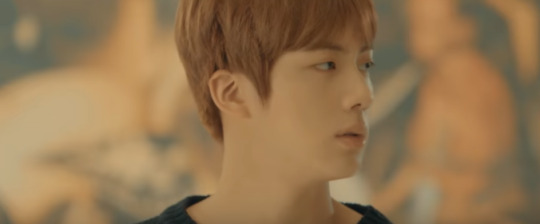
Look at this brownish tint. Mostly only Jin shows up for these type of scenes.
I also think it’s important to establish where BST chronologically fits among BTS’ MVs to understand who each member represents. I rewatched almost all of the MVs and I think the ones that are related to BST are the Korean “BST”, “I Need U”, “Run”, the BTS 화양연화 On Stage Prologue MV, and “EPILOGUE: Young Forever”. (I consider “Spring Day” another story by itself. Feel free to read our analysis of it to understand why that is so.)
The chronology of the story, in my view, is:
1. “I Need U”
2. “Run”/the BTS 화양연화 On Stage Prologue MV/Korean BST
4. “BST”
5. “EPILOGUE: Young Forever”
I think we can divide the MVs into external reality and inner reality (aka psychical reality). “I Need U”, “Run”, and the BTS 화양연화 On Stage Prologue MV focus on the external reality (The BTS 화양연화 On Stage Prologue MV does have psychical reality, but I think it’s more like a memory playback.) The other three MVs represent the psychical reality. The way they are filmed is different from the former three.
The starting point of the boys’ story would be “I Need U”. That is when we are introduced to all of the boys’ problems (eg V struggling with his broken family, J-Hope battling what’s likely a mental health problem, etc). We end this song with V killing his father to save his sister.
Next is “Run” where we see V fall back into the water, meaning that he has succumbed to darkness. He also leads the boys into mishaps and they all play pranks or do some petty crime together.
In the end, we find that Jimin is in a tub, burning a group photo of them. All of them have changed or matured and there’s no turning back now. I placed BTS 화양연화 On Stage Prologue MV with “Run” because I see the BTS 화양연화 On Stage Prologue MV as a time where V is reminiscing about the past.
Then we move into the psychical reality. We see in the Korean BST how the characters are struggling internally. Chronologically speaking, I think the Korean BST happens around the same time as “Run” and the BTS 화양연화 On Stage Prologue MV. As the boys are changing and being led by V for the external reality, the inner reality is also occurring. That’s where the Korean BST fits in. I placed BST after the Korean BST because we see Jin reminiscing about what has happened.
Finally, there is “EPILOGUE: Young Forever” where all of them have all grown up and are wishing to stay “Forever Young”. There’s a really dream-like state with this MV, so I consider it more of a psychical reality.
There is a chance that the boys have all died as a lot of fans have remarked, but in my opinion, the boys have just matured and though they wish to stay a boy, they have to become an adult. Their “youth” has died and not their actual selves. When we go through each boy, we see what they have gone through or left behind.
White ribbons are used in Korean funerals and white ribbons can also mean innocence and pureness in other cultures. At one point, the ribbon in Jungkook’s hand seems to have turned into a white feather–hope and then the white feather is shown by J-Hope’s feet along with the scattered pills.
The members will try to savour this blissful moment for as long as they can. I think this explanation matches the lyrics more like how J-Hope raps that “[he] wants to stay young forever”/”yeongwonhi sonyeonigo sipeo nan Aah”/”영원히 소년이고 싶어 난 Aah” (See credits for translation here). I think the huge irony here is that even though they want to savour youth, getting through youth is a challenge and a maze itself. That’s why they’re in this grey fenced maze that also resembles a cage. At the end of the day, you navigate through this maze and grow up, yet you also still become super nostalgic of those days. Ironic huh?

Look at this scary maze — youth.
(Side note: I quoted the romanized Hangul and Korean lyrics because I prefer to translate the phrase as “I want to stay as a young boy forever”. Though I’m not fluent in Korean, I am certain that “sonyeon” is “少年”. 少年 in Mandarin means a teenage youth or young boy (something like a boy of ages 10-16). To be honest, I feel like when the term is translated into English, it loses its beauty and what it embodies. 少年 embodies that growing up phase.)
(Just a another note: I am not an expert in Christianity. I only know references based on what I’ve learned in English Literature and Art. I also have not fully read Demian as I have a bit too much on my hands right now. However, I’ve read summaries on Cliff Notes and Coles Notes and read character analyses. Finally, I am not a psychology major, so I apologize if I’m not 100% clear with the psychological concepts. I’ve tried my best to understand them through research.)
Now that we have all the background settled. Let’s go onto who the members represent in BST beginning with J-Hope. I have decided to release this Memo into different parts.
Analysis
(1.1) J-Hope acts as a guide. J-Hope is Archangel Michael and Frau Eva from Demian.
Throughout BST, J-Hope is like a guide. We first see him sitting in front of Michelangelo’s Pieta. Pieta depicts Virgin Mary who holds onto Jesus Christ’s deceased body after his crucifixion. We are past the scene where Jin looks through the painting, The Fall of the Rebel Angels, with some binoculars, so we know that we are in a chaotic stage of war. Notice how when the painting is zoomed in, we only see the images of the monsters and rebel angels and the Archangel in the centre is completely black.

Jin with the binoculars (setting = reality based on how it’s filmed)

No Archangel here. Just monsters and rebel angels.

Reference to the Devil from the Korean BST.
Then the first time we see J-Hope, nearly everything is pitch black, except for him and Pieta. The neon pink/yellow light symbolizes that he is here to show the light. J-Hope has a sword in his hand; we know from a lot of stories, noble knights or Kings have to fight with a sword (ie King Arthur/Lancelot etc). Similarly, he has to fight off the bad angels.

Neon pink in BST meaning that “there was war in heaven: Michael and his angels fought against the dragon; and the dragon fought and his angels,” (Book of Revelations, 12:7)
As Archangel Michael, J-Hope chases V who is likely Lucifer from Heaven and brings about the demise of the Rebel Angels. Jimin and Jungkook are seen restraining V, the Fallen Angel. You’re probably wondering how these two can be helping J-Hope when they too have fallen into despair. I think the only reasonable way to explain it is that each member starts their story at a different time. Jimin and Jungkook were saved first or have matured enough to realize that the Fallen Angel needs to be out of Heaven.
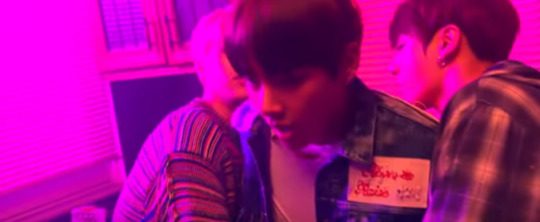
Jimin and Jungkook are restraining V (the Fallen Angel).
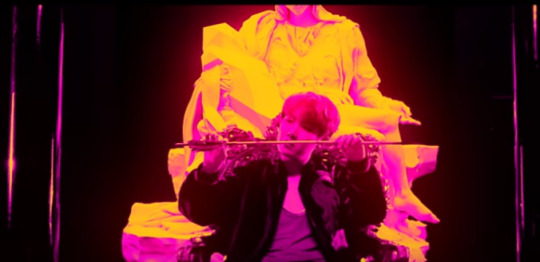
Reminder that J-Hope is the one holding the sword.

I am pretty sure that this is J-Hope shooting at V because in his other outfit, he is wearing the same sweater as the one here.

After all, right after the scene above, we see J-Hope with a bow and arrow.
We never get to see who exactly is the one that aims at V. However, we see in the subsequent scene that J-Hope is the one shooting his bow and arrow. In the Bible, a bow is the doctrine of truth and good: “Jehovah’s arrows are sharp, and all His bows are bent, the hoofs of His horses are counted as rock, and His wheels as the whirlwind” (Isaiah 5:28) (See this website for more explanation). After he shoots that arrow, the doctrine of truth and good are spread to all of the boys. We see the boys hanging out with J-Hope after there’s a small clip of V being in pain.
Then we notice J-Hope pouring down some pills in a cauldron which lets the truth explode. In a way, I think it could be that J-Hope is foretelling what “may” happen, but I think it is more likely that he is telling us what “has” happened. This is because the next scene is Jin looking around in the present and after that we cut to V and Jin.
(Just a little note: When J-Hope is with the boys or in his lounge room, he is wearing a sweater that is pieced together in many parts. Half of it is black and red and the other is grey, white, and blue. I suddenly got the feeling that the red and black reminded me of Jin’s outfit throughout this whole MV. In a way J-Hope seems to embody both Good and Evil at this stage after fighting the war.)
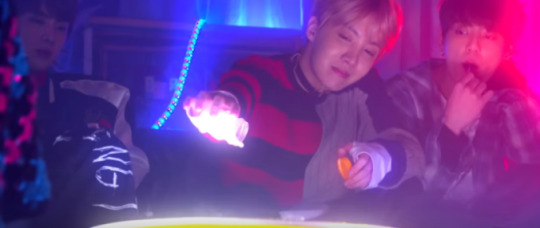
J-Hope pouring some pills down and revealing fortunes or the past.
Based on the two filming styles, I think the V and Jin scene feels more like the past. Jin keeps hitting V and then mouths a “Sorry”. This somehow makes me feel that Jin is really enraged that V led Jin or all of them down the wrong road. After all, if we take a jog back memory lane, we will notice that V is always the one leading the group to do something. V is the only one that jumps from that high contraption in BTS 화양연화 On Stage Prologue MV.

V being the first to jump and to lead the group to elsewhere
That jumping scene is more likely a memory of the past as we first see V with bloody hands in BTS 화양연화 On Stage Prologue MV, meaning that he has already committed the murder. He keeps trying to wash off the blood but like Lady Macbeth in Macbeth, his hands are stained. Right after this short scene, the lighting in the MV changes to give off a bright yet nostalgic vibe and then there are clips of happiness. Therefore, it’s likely V’s memory of the happier times. I think this theory works because this is also a Prologue MV leading to Butterfly.
In “Run”, V is also the first one that has plunged into the water because he has sunken too deep via the murder. After his plunge, we are shown Rapmonster who dumps some sugar into his cup of coffee. This act symbolises that similarly, all the boys have subsequently fallen into darkness after V’s crime. In “I Need U”, we already know that all the boys suffer from problems. However, V is the only one who commits arguably the biggest crime out of the boys: V has murdered his father. Therefore, these all prove that V is the one that has led the boys astray.
Also, closer to the end of”I Need U”, J-Hope is the one pouring down pills. In the beginning of “I Need U”, he seems to have to rely heavily on pills as we see him with his pill cabinet. His external reality is likely dealing with a mental health issue which is why he also suffers a lot in his psychical reality. (It could be non mental health related illness as well; we don’t really know that much based on the clips.)

J-Hope pouring pills in this fire in “I Need U”

J-Hope pouring pills in this cauldron in BST
Let’s go back and contrast this “I Need U” pill pouring scene to the BST one. Somehow I keep getting reminded of the Three Witches in Macbeth. I wouldn’t say J-Hope fully embodies the Three Witches because there are three of them and J-Hope doesn’t start any of the MVs. However, I think there is a subtle inference that J-Hope may have been like Three Witches who planted the seed of temptation in Macbeth’s mind to kill King Duncan. Although this pill pouring scene is shown among all of the boys changing towards the end of the MV, there are also clips of the boys’ happy youth where they are playing with fireworks and I’m pretty sure they all gathered around a fire way before V killed his father.

V coming in to rescue his sister and ends up killing his father.

Jimin sinking to despair

Happy Jungkook at the group camp fire

Everyone playing with fireworks (in the past)
Therefore, when he pours the pills in his external reality, he is foreshadowing the darkness that will come and perhaps in a very subtle way, he has influenced V to act. However, unlike the other boys who have succumbed to darkness, J-Hope is able to break free from temptation and is the bearer of truth in the inner reality. He dumps the pills once more in BST, becomes the one that awakens from this chaos, and has to punish V, the Fallen Angel.
Now that we have established how J-Hope fits as Archangel Michael, we can see how J-Hope can also be Frau Eva who represents the anima. Anima and animus are concepts developed by Carl Jung. Anima is “the woman in men” (See here for more info). The Anima’s archetype is the mother figure. It’s quite fitting that Pieta, which shows the Virgin Mary, is right behind J-Hope. Moreover, in Demian, Demian gives a kiss from Frau Eva to Sinclair. As a result of the kiss, Sinclair who represents the conscious ego is able to combine with Demian (the self) and merge with Frau Eva (the anima). Throughout the novel, Frau Eva’s role is also to help Sinclair grow. As a result, J-Hope has helped all of the other boys mature and the boys are thrown back to the external reality.

Look behind J-Hope!
As for himself? J-Hope is left behind and gazes up to this sky that features an ominous green butterfly/pair of wings. I initially saw this as a butterfly; butterflies generally symbolize great transformation. Think of a caterpillar who changes into a butterfly. Wings gives a different meaning like freedom, independence, and in the Bible, wings are known to be spiritual truths (See here).

All of the boys have gained some form of truth and returned to the external reality which is in green. Green is associated with nature and the Earth. I’m pretty sure in BST, green here is used to represent when the characters are in the external reality.
Whenever this neon green is used, the scenes are related to the characters being in the inner reality. We first see this neon green when Rapmonster and Jungkook are sitting across from one another and Rapmonster tempts Jungkook. Notice how the neon green is on the exterior of the windows and how the Hotel is outside of this building. Jungkook was in a hotel at the beginning. The last three pictures show the ending scenes of the MV. There is V who has been punished looking up to the green sky (external reality). There is Jungkook who is going through that weird neon green/blue light to get back to the external reality. There’s Jin looking down at the vortex and stepping away from it. The green sky is all around him. He too is getting back to the external reality.
I haven’t figured out which member to analyze for the next post, so please feel free to let me know who you’d like to understand first!
#adulthood in blood sweat tears#arrow in bst#bangtan#bangtan boys#bangtan boys BST MV Japanese version theory#bangtan boys BST mv theory#bangtan sonyeondan#bangtan sonyeondan BST#blood sweat & tears symbolism#blood sweat & tears symbols#Blood Sweat Tears Japanese version analyzed#Blood Sweat Tears Japanese Version MV#blood sweat tears mv theory#BST#BST Japanese MV meaning#BST Japanese MV theory#BST Japanese ver explained#BST Japanese ver theory#BST mv analysis#BST MV meaning#BST mv review#bts#bts blood sweat tears#BTS BST Japanese version theory#BTS BST MV analysis#bts demian#bts epilogue young forever theory#BTS 화양연화 On Stage Prologue MV analysis#BTS 화양연화 On Stage Prologue MV explained#BTS 화양연화 On Stage Prologue MV theory
35 notes
·
View notes
Text
We’re not a blog that is dedicated to reviewing music (including Kpop), but because we absolutely adore BTS and their music, we decided to do a memo-style review of the Music Video (MV) for their Japanese Version “Blood, Sweat & Tears” (血、汗、涙 -Japanese Ver.-).
***Note: If this is your first time browsing the Drama Files, please read The Rules on how our Memo-style reviews work.***
***Note: We really wanted to analyze the Blood, Sweat, Tears Korean MV before, but we missed out on the opportunity. We thought this MV was very interesting as well, so we were really eager to share our theories about what they could possibly signify. There are definitely many theories, so we thought we’d propose ours. Our views are simply theories and purely speculative.***
Memo
Dear Reader,
There have been some questions regarding the recent release of BTS’s 血、汗、涙 -Japanese Ver.- (“BST”), particularly:
(1) Who/What does each member represent?
(2) How is the ending clip that is reminiscient of the “I Need U” MV connected to BST?
Conclusion
(1.1) J-Hope acts as a guide. J-Hope is Archangel Michael and Frau Eva from Demian.
(1.2) V is Max Demian (“Demian”) from Demian and the Devil/Lucifer/the Fallen Angel (“the Devil”) .
(1.3) Suga is Pistorius and the Old Wise Man (archetype).
(1.4) Jimin is Sinclair from Demian and Adam from the Bible.
(1.5) Jungkook is Icarus and Sinclair from Demian.
(2) This will be answered in a subsequent Memo.
Background
Please read the first post to understand how this MV fits in with the other MVs and the different types of reality in this MV.
Please read the second post for more information on Demian and other important concepts.
Please read the third post for a detailed analysis of Suga’s role.
Please read the fourth post to understand Jimin’s role.
Analysis
(1.1) J-Hope acts as a guide. J-Hope is Archangel Michael and Frau Eva from Demian.
Please read the first post to see this analysis.
(1.2) V is Max Demian (“Demian”) from Demian and the Devil/Lucifer/the Fallen Angel (“the Devil”) .
Please read the second post to see this analysis.
(1.3) Suga is Pistorius and the Old Wise Man (archetype).
Please read the third post to see this analysis.
(1.4) Jimin is Sinclair from Demian and Adam from the Bible.
Please see the fourth post for this analysis.
(1.5) Jungkook is Icarus and Sinclair from Demian.
(i) Jungkook is Icarus.
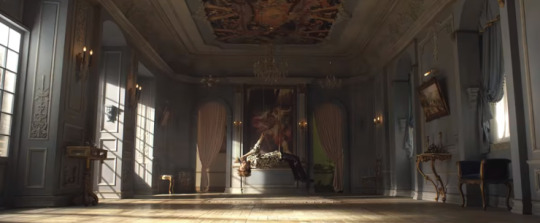
Jungkook swinging on the swing
We see signs in the Korean “BST” MV that show Jungkook as Icarus. We see the painting behind Jungkook, which is “Lament of Icarus” by Herbert James Derper. To the right is another painting about Icarus, “Landscape with the Fall of Icarus” by Pieter Bruegel the Elder.

Look at Jungkook flying back/falling. Behind him is the painting, “Lament of Icarus” by Herbert James Derper and to his right, you see the painting, “Landscape with the Fall of Icarus” by Pieter Bruegel the Elder.
The myth is that King Minos hired Daedalus to build a palace and a maze (Labyrinth)to imprison Minos’ son, the Minotaur. Minos also imprisoned Daedalus in the Labyrinth because Daedalus gave Minos’ daughter, a clew, to help Minos’ enemy, Theseus, to defeat the Minotaur and beat the Labyrinth. Daedalus’ plan to escape was to build wings out of wax and feathers to fly away. He fashioned wings for both himself and his son, Icarus. He warned Icarus not to fly too close to the sea or the sun and to follow Daedalus’ flight path. However, Icarus did not listen.
Jungkook first starts off swinging on the swings in the Korean “BST” MV and then leaning back like he’s flying. After, he fully falls back and the swing is gone, meaning that he is like Icarus who chose not to listen to his father and flew too close to the sea. There are bits of what seem like white feathers floating in the air to represent the melted wax and feathers from the myth.
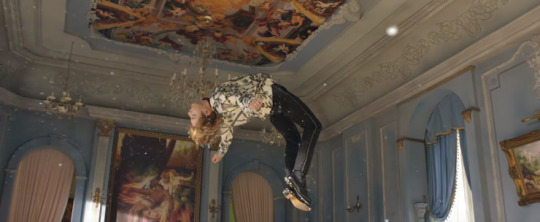
The paintings are even clearer and damn that move must have been exhausting for JK!
Remember how in the older BTS MVs like “Run” and “I Need U”, RM is shown with a lollipop in his mouth. Here, we see Jungkook with a blue lollipop in his hand. The lollipop, in a sense, is like our desires that we know aren’t good yet we still consume them. Lollipops can also mean a new adventure starting, which is true in Jungkook’s case as he is going through a transformation. After we see Jungkook suck on the lollipop, we get a scene of RM showing a dropping sign with his fist and then we get transported down a level of a building to meet Suga and RM.
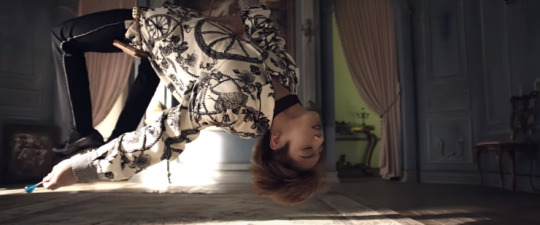
Look at the blue lollipop!

Eats lollipop then . . . tumbles down . . .

Drop down! (RM is in the same room as JK who was swinging on the swing there)
RM is also going through a big transformation as he drinks the green liquid, which is likely absinthe. I’m going over RM’s part and Suga’s part a bit here because RM and JK are closely connected in both the “BST” MVs. I won’t go into extreme detail with the two other members as this post focuses on Jungkook, but it’s still important to recall how Jungkook is linked with these two members. Here’s a little chart I’ve made, which has been used in a previous post.
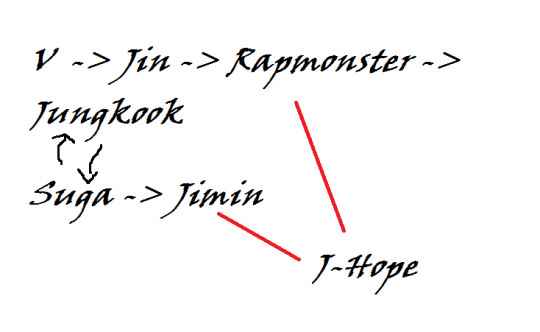
RM influences Jungkook (see the black arrow leading from RM to JK) and in turn Jungkook and Suga both influence each other. I’d say Suga is more like Daedalus than RM because Suga in the “BST” MV tries to pull Jungkook away from temptation, whereas RM leads Jungkook to temptation.
In the “BST” MV, we still see signs that prove that Jungkook represents Icarus. In the beginning of the MV, Jungkook is lying on this white plastic sheet. The walls are all painted in bright neon colours, which represents the psychological reality. Then, he gets up from his spot and looks back to see a pair of red wings behind him. Icarus, as mentioned before, flew with wings made of feathers and wax. The red colour likely symbolizes that Jungkook has fallen and has been “tainted”.
(Remember to focus on Jungkook’s clothing in this “BST” MV. Jungkook here is wearing a plaid jacket. He also later wears a hoodie with the writing “Thirteen”.)
(ii) Jungkook is Sinclair from Demian.
I think it’s interesting to note that the whole BST is really a matter of perspective. From one member’s POV, another member is a certain character. However, when you view it from a different member’s POV, then one member can represent another character. Let’s try to apply it in this case.
Jungkook, in the Korean “BST” MV, succumbs to RM’s temptation. Jungkook is Sinclair and RM is Demian in that view. However, from RM’s POV, RM is Sinclair and Jin is Demian (This will be explained further in the next post).
In the external reality, Suga is still Pistorius to Jungkook who is Sinclair. Remember that Suga is the one trying to pull Jungkook away from the toilet like how Pistorius is instilling the standard biblical beliefs to Sinclair.
Also, Jungkook here is wearing a “Thirteen” hoodie. The number “thirteen” is normally seen as an unlucky number like Friday the thirteenth and receives a darker form of symbolism. Often, apartments or hotels will also not have a button for the 13th floor. In Norse mythology, the 12 Norse gods hold a party; however, Loki, the trickster, was an uninvited guest and was the 13th to arrive. Later, we learn that Hoor slayed Baldur, using a magical spear given by Loki. We also see from the Bible that the Last Supper comprised of 13 attendees (12 disciples and the Christ). Thirteen is seen as an omen as Christ suffers from a tragic fate.
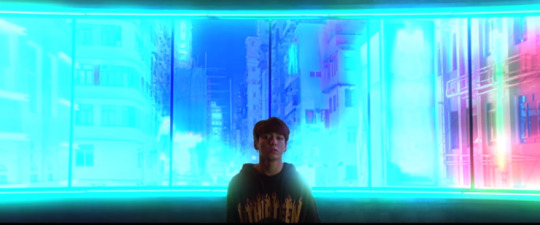
Look at his hoodie’s word: “Thirteen”.
However, thirteen can have a brighter interpretation. For example, Christ and Baldur can be considered the enlightened guests. Therefore, the number, thirteen, can be said to be associated with enlightenment, ascension, and resurrection. We also see from an Egyptian tale that Osiris, the Egyptian God of life and death, was killed by Typhon, his brother. Typhon then stole Osiris’ body and chopped it into 14 pieces. Meanwhile, Isis, Osiris’ wife, could only find 13 parts of his body. Therefore, thirteen can be said to be the precursor of completion. (See here for more info about the number, 13.)
Here, since the word “thirteen” is written in a font that looks like it’s burning, there seems to be more of an interpretation of resurrection. Phoenixes are known to be reborn upon burning in flames. Therefore, Jungkook can be said to be experiencing a rebirth after succumbing to temptation. I wouldn’t say that going to a “dark” side is necessarily bad, as I’ve suggested in my previous posts based on Demian‘s interpretation of events.
Going back to how Demian applies to the relationship between Jungkook and Suga, recall that in Suga’s post, Sinclair eventually says a lot of harsh words to Pistorius and Sinclair’s friendship with Pistorius comes to an end. Similarly, the toilet scene is like Jungkook pushing his “master” away and surpassing his mentor. Jungkook’s relationship with Pistorius ends and rejects the standard biblical ideas.
Jungkook is also tempted by RM, who acts as Demian, once he enters the psychological reality. RM brings the absinthe to Jungkook. Jungkook has taken a seat, which seems to imply that he has accepted RM’s offer. RM then makes Jungkook drink the absinthe and Jungkook goes through an interesting experience. Notice that Jungkook is wearing the “thirteen” hoodie when he’s in the psychological reality world. He gets transported on a truck that Jin has been driving since the older MVs and at the very end of this “BST” MV. Jin, at this stage, is already Demian, so it’s interesting to see that Jungkook, a variant of Sinclair, is being taken away by Demian to experience a different world.
Once Jungkook has experienced this mental change and transformation, he is brought back to the external reality where there is a black cloud hovering around Jungkook with the hoodie. The Jungkook wearing the plaid blazer is transported back to the external reality. At the end, Jungkook is a changed person.
Another evidence that Jungkook is Sinclair from his short clip. We see him lying on this bed, which is similar to his situation in the beginning of the “BST” MV. He is tossing and turning in this bed. Then we see him closing his eyes and there’s a burning piano, which has been mentioned in a previous post as being linked to Suga as Pistorius.
We see a narration of a quotation from Demian and Jungkook, in a white button-up with a sparrow hawk on his heart. This quotation “because it’s darkest at dawn right before the sun rises” is from BTS’ song “Tomorrow” and then the next one is “The fifteen year old me who didn’t have anything” comes from his song, “Begin”. Here, Jungkook is like Sinclair who starts off in a very sheltered, structured family. I think it’s interesting that this quotation was picked because “Tomorrow” is about following your dreams and struggling with these. It makes sense that that particular line of “Begin” was used because it sets the tone that Jungkook was young then.
Then Jungkook has this painting in his hand of a young boy. After, he starts painting this larger portrait of another boy and as he is painting, the scene of a piano burning is seen through his eye. The painting then bursts into flames. Jungkook becomes very distressed upon viewing the portrait more. The portrait’s young boy seems to change in its appearance.
The changing painting is reflected in Demian as well. At first, Sinclair is inspired by Beatrice, a woman he meets after walking in a park, to paint. He tries to reproduce her face, but fails. This is like that scene in Jungkook’s short film where he first sees a picture of a person and then proceeds to paint it.
After Sinclair lets his imagination do its work and he paints again. When the painting is complete, it looks half-masculine and half-feminine, ageless, and mask-like. When he wakes up from another dream, he believes that the face knows him and calls to him. Sinclair notices this weird brightness at the painting’s forehead and its eyes and recognizes it as Demian. However, after placing the painting to his window and letting the light shine through it, he realizes that the painting is actually a reflection of himself, his daemon, and his inner self. This whole scene happens in a dream-like state, so whether he actually puts the painting to the window is up for debate.
This part of the scene in Jungkook’s short film has also been portrayed when he watches the painting burn and turn into another painting. Jungkook is struggling to believe what he is seeing and is crying a bit too. It first looks like Taehyung, who we’ve said is Demian to Jin, but then if you look carefully, it also seems to look like Jungkook. Jungkook realizes that the painting is actually himself, which is just like what we’ve seen in Demian.
In Demian, Sinclair then starts recalling his last meeting with Demian. Demian and Sinclair talk about Sinclair’s rebellious stage. Demian notices that Sinclair has been drinking and frowns upon that habit; however, Demian points out that sometimes a life of hedonism is a precursor to sainthood and refers to St. Augustine as an example of this concept. In his youth, St. Augustine lived a hedonistic lifestyle where he was related to several young men who bragged about their sexual adventures. He also had an affair with a young woman. It wasn’t until he was 31 did he convert to Christianity and wrote extensively in the areas of theology, sociology, and philosophy. He developed many ideas related to Christianity as well. Sinclair identifies with this example that Demian has given and believes that Sinclair’s life is headed in a similar direction as that of St. Augustine.
On the night of this flashback, Sinclair has a nightmare where Demian forces him to swallow this coat of arms above this doorway. He senses that this bird is bursting into life within himself and starts to eat his insides. After this dream, Sinclair begins to paint this bird.
After Sinclair finishes the painting, we see that he has painted a sparrow hawk. The sparrow hawk is trying to break free from this dark globe; it’s like it is hatching from an egg. However, this sparrow hawk is fully grown, and so this means that this painting is about rebirth.
Here, the egg is an archetype, formed through Sinclair’s collective consciousness. The egg has its origins to the Roman times where Bachofen, a late anthropologist, claims that it represents the two poles of the world. Therefore, the sparrow hawk, which is breaking out of the egg to be reborn, is breaking the world of false polarities, unreal, and the arbitrary.
Going back to the short film, we see that Jungkook is holding onto this picture of a sparrow hawk and staring at it. The final scene ends with Jungkook standing in the middle of the room and his shadow has grown wings. These scenes are similar to those of Sinclair. Though we don’t see Jungkook going through a memory recall of a meeting with Demian, we have seen him waking up from nightmares before. We aren’t sure whether he has actually painted the sparrow hawk, but that sparrow hawk is just like the one described in Demian. Moreover, the fact that Jungkook has grown wings shows that he is going through a rebirth like in Demian. This also indicates that Jungkook has activated the part of himself that wants to be broken free.
It’s interesting to note that Jungkook is also wearing a “sparrow hawk” button-up shirt. That’s a signal that supports the notion that he wants to be free from his past views. That’s why his eyes show the burning piano–a remnant of the old principles.
Memo: “Blood, Sweat & Tears” (Japanese Version) Music Video Analysis Part 5 We're not a blog that is dedicated to reviewing music (including Kpop), but because we…
#&039;피 땀 눈물 (Blood Sweat & Tears)&039; Official MV#&039;피 땀 눈물 (Blood Sweat & Tears)&039; Official MV analysis#&039;피 땀 눈물 (Blood Sweat & Tears)&039; Official MV analyzed#&039;피 땀 눈물 (Blood Sweat & Tears)&039; Official MV explained#&039;피 땀 눈물 (Blood Sweat & Tears)&039; Official MV review#&039;피 땀 눈물 (Blood Sweat & Tears)&039; Official MV reviewed#&039;피 땀 눈물 (Blood Sweat & Tears)&039; Official MV thoughts#bangtan#bangtan boys#bangtan boys blood sweat & tears explanation#bangtan boys blood sweat & tears mv review#bangtan boys BST MV Japanese version theory#bangtan boys BST mv theory#bangtan sonyeondan#bangtan sonyeondan BST#blood sweat & tears analysed#Blood Sweat & Tears Analysis#blood sweat & tears and demian#blood sweat & tears critique#blood sweat & tears demian#Blood Sweat & Tears Explained#Blood Sweat & Tears Explanation#Blood Sweat & Tears fan theory#blood sweat & tears japanese music video#Blood Sweat & Tears Japanese MV#Blood Sweat & Tears Japanese MV analysis#Blood Sweat & Tears Japanese MV Analyzed#blood sweat & tears japanese mv critique#blood sweat & tears japanese mv jeon jungkook#blood sweat & tears japanese mv review
0 notes
Text
We’re not a blog that is dedicated to reviewing music (including Kpop), but because we absolutely adore BTS and their music, we decided to do a memo-style review of the Music Video (MV) for their Japanese Version “Blood, Sweat & Tears” (血、汗、涙 -Japanese Ver.-).
***Note: If this is your first time browsing the Drama Files, please read The Rules on how our Memo-style reviews work.***
***Note: We really wanted to analyze the Blood, Sweat, Tears Korean MV before, but we missed out on the opportunity. We thought this MV was very interesting as well, so we were really eager to share our theories about what they could possibly signify. There are definitely many theories, so we thought we’d propose ours. Our views are simply theories and purely speculative.***
Memo
Dear Reader,
There have been some questions regarding the recent release of BTS’s 血、汗、涙 -Japanese Ver.- (“BST”), particularly:
(1) Who/What does each member represent?
(2) How is the ending clip that is reminiscient of the “I Need U” MV connected to BST?
Conclusion
(1.1) J-Hope acts as a guide. J-Hope is Archangel Michael and Frau Eva from Demian.
(1.2) V is Max Demian (“Demian”) from Demian and the Devil/Lucifer/the Fallen Angel (“the Devil”).
(1.3) Suga is Pistorius and the Old Wise Man (archetype).
(2) This will be answered in a subsequent Memo.
Background
Please read the first post to understand how this MV fits in with the other MVs and the different types of reality in this MV.
Please read the second post for a background on Demian and other important concepts.
Here is some background information about Pistorius. In Demian, Pistorius is an organist whom Sinclair meets after his rebellious phase in boarding school. Sinclair also meets Pistorius after discovering a note in one of his books and the note talks about Abraxas. During one of his walks, he hears some unorthodox organ music and then meets Pistorius. Pistorius is the son of a well-respected clergyman and is a theologian as well. Pistorius sees mythology and religion as being connected, which made him inappropriate to act as a clergyman. Pistorius ends up becoming Sinclair’s mentor and teaches him in his room, before a fireplace. Although Pistorius shares interests in Abraxas and teaches Sinclair many concepts, Pistorius still chooses to accept/stay with the traditional view of Christianity.
Analysis
(1.1) J-Hope acts as a guide. J-Hope is Archangel Michael and Frau Eva from Demian.
Please read the first post to see this analysis.
(1.2) V is Max Demian (“Demian”) from Demian and the Devil/Lucifer/the Fallen Angel (“the Devil”) .
Please read this post for more information on V.
(1.3) Suga is Pistorius and the Wise Old Man (archetype).
Jubiemon J: We will first look at Suga’s character based on an analysis of Pistorius in Demian and then we will see how he fits in with one of the Jungian archetypes.
(i) Suga is Pistorius due to his connection with the piano/organ, his pairings with Jungkook and Jimin, and his short clip “First Love”.
First, in both “BST” MVs, Suga is always associated with a piano or organ. (Side note: I know in the MVs, pianos are used instead, probably because of an ease of transportation. However, in the Korean “BST” MV, we hear Suga playing the organ during one of the MV breaks. That’s why I say “piano or organ”.) Likewise, Pistorius is . . . an organist!

Suga the pianist in the Korean “BST” MV!
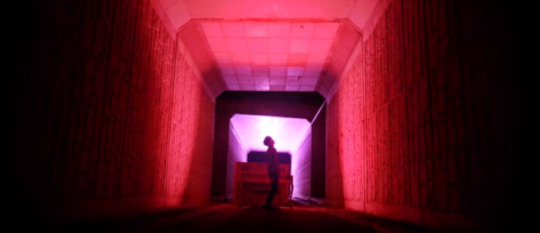
Suga in “BST” with the piano behind him!
Secondly, Suga has a mentor/mentee relationship with two of the members, Jimin and Jungkook.
This relationship works because of a couple of assumptions:
(a) A character’s identity based on Demian changes depending on the member’s relationship to another and that at some point, everyone starts out as a Sinclair. The only character that is fixed is J-Hope’s (See Figure 1: Chart of Relationships below.)
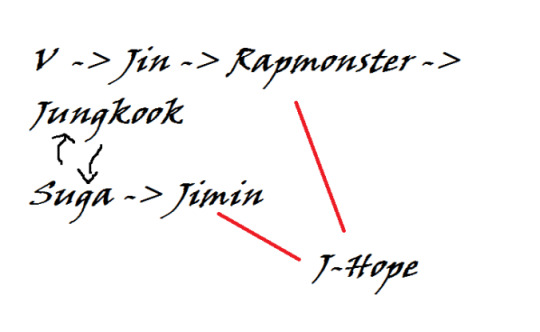
Figure 1: Chart of Relationships
(b) For the Korean “BST”, ““I Need U”, “Run”, and BTS 화양연화 On Stage Prologue, there are different timelines going on.
There will be a memo giving a summary of all the relationships. For now, we will just focus on the Suga/Jungkook and Suga/Jimin pairings as this post is about Suga. The arrow means “influences”. The red line means “connects”. J-Hope connects to everyone. Suga influences Jimin. Jungkook influences Suga and Suga also influences Jungkook.
Suga/Jungkook pairing
In the MVs for “BST” and “Run” and the short clip/teaser for Jungkook’s “Begin”, we see Jungkook and Suga being grouped as a duo. Jungkook is Sinclair and Suga is Pistorius.
In Jungkook’s “Begin” clip, Jungkook holds a drawing of Suga and there is also a drawing of Suga on the wall. We then see a painting in front of Jungkook. It’s hard to tell who that painting is of; it could be Suga, V, or Jungkook. (This will be explained in detail in Jungkook’s post.) In the chapter, Jacob’s Fight with an Angel, which is where Pistorius is introduced, Sinclair also looks at a painting that is of a half-male/half-female. The painting then continues to change forms and Sinclair also claims he had burned it. That’s similar to the short clip.
Now that we see that Suga is connected to Jungkook. We will examine their relationship. Suga and Jungkook only interact with each other in the external reality. In “Run”, Suga is the one that seems to want to start something and Jungkook is restraining him. I think that’s more or less symbolic that Jungkook is somewhat resisting change. It’s analogous to the scene in Demian where Pistorius challenges some moral beliefs that Sinclair held. Sinclair believes that murdering someone you hate is still wrong. Pistorius says that if we want to murder someone we hate, it’s because that person possesses something that we hate within ourselves.
Suga is able to dominate Jungkook who is left on the ground, injured. By Suga throwing a chair at the mirror that shows blue roses in a vase, he is breaking what seems to be the “unattainable”/”mystery” and lets Jungkook see more of the truth.
Blue roses don’t exist in nature. Blue flowers are generally rare (See here for more explanation.) Blue roses can mean mystery, the unattainable/impossible, new opportunities, and new possibilities (See here).
Notice how it’s the mirror that’s broken and not the actual vase of roses; that’s an important distinction because mirrors tend to represent identity, self-consciousness, as well as the “oppositional themes of reality and illusion, candor and deception, logic and disorder, narcissism and self-loathing, symmetry and imbalance, and flattery and harsh indifference” (See here). On one hand, we see a better self and the world that we live in, yet we also see our subconscious self. In art, mirrors are associated with self-knowledge and vanity due to the Narcissus myth. Moreover, in Christian art, mirrors mean the purity of the Virgin Mary (Look here). Breaking that mirror is also breaking the traditional sense of “purity” and destroying what we know as ourselves (ie illusion).
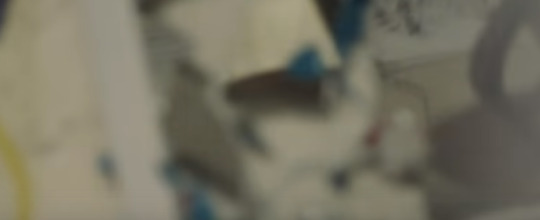
Mirror breaking…not the vase + flowers!
Pistorius also says in the beginning of the chapter to Sinclair: “[Y]ou accuse yourself of taking a road different from most people. You have to unlearn that. Gaze into the fire [. . .] don’t ask whether it’s permitted or would you please your teachers or father, or some god. You will ruin yourself if you do that.” Pistorius is telling Sinclair that Sinclair must break free of what he once believed.
Sinclair eventually says a lot of harsh words to Pistorius like he is antiquated and Sinclair’s friendship with Pistorius comes to an end. Pistorius admits that he still chose to stick with the traditional view of Christianity. Pistorius explains:
I have the desire to become a priest, as you know. I wanted most of all to become the priest of the new religion that we have so many presentiments of. I’ll never be able to–I know that, and I’ve known it for a long time, though I never fully admitted to myself. […] But I must always be surrounded by I feel to be beautiful and holy, organ music and mystery cult, symbol and myth; I need it and I won’t give it up. –That’s my weakness. Because I know at times, Sinclair, I know sometimes that I shouldn’t have such desires, that they represent a luxury and weakness. […] But I can’t (p. 84, Jacob’s Fight with the Angel).
This is like in “BST” where Suga is the one trying to pull Jungkook away from the toilet.
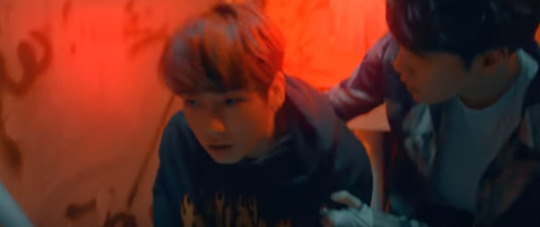
Suga pulling Jungkook away
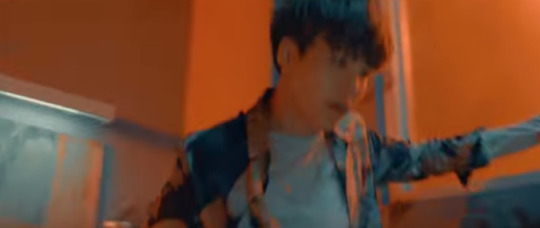
Jungkook pushes Suga away.
Jungkook, in the Korean “BST” MV and in “BST”, ends up succumbing to Rapmonster’s temptation, the absinthe drink. This time it is Jungkook who ironically pushes Suga away and surpasses his mentor. Jungkook is Sinclair and Rapmonster is Demian here. Remember that in the external reality, Suga is still Pistorius to Jungkook, who is also Sinclair.
Suga/Jimin pairing
In the Korean “BST” MV, we only see Suga being paired with Jimin. Suga is the one that’s covering Jimin’s eyes or putting a blindfold on him. Suga is Pistorius and Jimin is Sinclair.

Jimin, as Sinclair, starts out having his eyes covered just by Suga’s hands. He is still not exposed to the harsh reality. Later we move from Rapmonster and Jungkook with the green smoke and up to Jimin and Suga, who are kneeling across from each other. Rapmonster, Demian here, and Jungkook, Sinclair here, are on a level lower than the other two. Pistorius never dives deeper and breaks free from traditional views of the world and Jimin, who is acting as Sinclair here, is at a point where he has just met Pistorius.
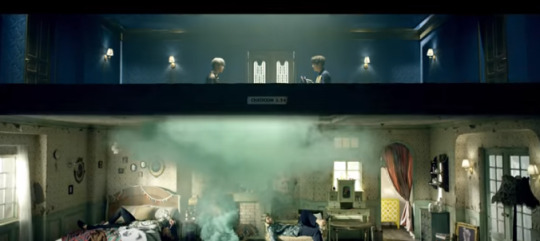
Also notice how Jimin is holding a red apple, while Suga is grasping a black blindfold.

Apple in Jimin’s hand vs black blindfold in Suga’s hands
Blindfolds are important symbols. In Law, Lady Justice wears a blindfold, meaning that a blindfold symbolizes objectivity and impartiality (See here). They can also represent resistance to clarity and mean the interplay between the conscious and the unconscious. Wearing a blindfold symbolises a lesser state of consciousnesses, while taking it off is like an awakening (Source).
The shade black is related to power, authority, death, mystery, evil, rebellion, and strength (Source). In art, the meaning of black changes throughout the periods: in the early Christian period, black was related to evilness, while in the medieval era, it symbolized royalty (Source).

In this case, I think that the black blindfold works to encompass nearly all of the meanings. Jimin is becoming more aware and objective as he wears the blindfold, meaning that he accepts Suga as his mentor. This is like how Sinclair starts to learn from Pistorius. However, by learning from Suga, Jimin is also in a lesser state of consciousness; like mentioned before, Pistorius is still attached to the traditional views of Christianity. There’s power through learning about oneself. There’s a sense of a rebellion from being different from others. There’s also death of one’s old self and mystery in the process of self-discovery. Others might view this change as being evil; hence, Jimin is holding onto that red apple. We know that red apples symbolize the apple from the Garden of Eden. Apples are temptation. Jimin is struggling with temptation here.
Okay, so the question that’s probably lingering in your mind would be this: How can we have two Sinclairs and two Pistoriuses? Remember that we’ve said that the scenes with Jimin, which are filmed in this blue-ish tint, represents the deeper self which is part of the psychical reality.
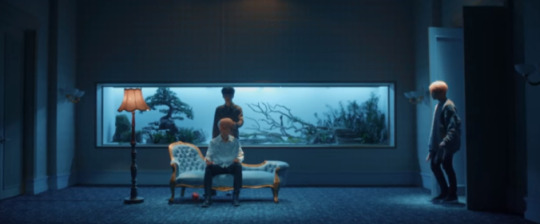
Blue tint!
In fact, Jimin represents all the Sinclairs that are searching for one’s shadow, so you can say that Jimin is an extension of Jungkook, Jin, and Rapmonster.
(Side note: There will be detailed posts about these members later, but for clarity’s sake, a shadow is the unconscious part that we don’t identify with and often associate as the “dark side”.)
If the Pistorius – Sinclair relationship is shown by Suga and Jungkook in the external reality, then that relationship in the inner/psychical reality is depicted by Suga and Jimin.
Finally, Suga is Pistorius because of what’s seen in his short clip: “First Love”. Although it seems like he starts out as Sinclair, he ends up being Pistorius due to his return to his burnt piano. Suga’s MV is positioned at #4 out of the 7 clips. Rapmonster first narrates these lines from the chapter, Beatrice, in Demian.
There are numerous ways in which God can make us lonely and lead us back to ourselves. This is the way he dealt with me at the time.
Beatrice is the chapter that comes before Sinclair meets Pistorius; this is important because it shows that at this point, Suga is kind of like Sinclair. In many ways, Pistorius and Sinclair are quite similar: they are both eccentric and alone and share different views from others. That’s why Rapmonster says those sentences from that chapter where Sinclair has his rebellious stage during boarding school. He goes to bars and gets drunk often.
In the short clip, we see Suga breaking into a store to play the piano until he suddenly stops.
He hears this whistling that attracts him away to the streets that are filled with darkness. A car comes towards him, nearly hitting him. Instead, the car crashes right into the store with the piano. The piano ends up burning. Suga is seen going back to the burning store after he thinks to himself: “Would I have changed? If I had chosen a different path?” (See here. To be honest, I can’t read Korean, so I just have to assume that this translation is accurate. Translation, to me, is an art and you have to be careful about the word you choose to use. In some languages, some words just don’t have the exact meaning in the other language.) Then, Suga watches the burnt piano and stays there.
This whole scene proves that Suga ends up being Pistorius because although he is also attracted to Abraxas like how he follows the whistling and ends up being on that dark street, Suga goes back to the burning piano. We know that the piano/organ is connected to Pistorius. We also know that Pistorius admits that he is not “capable of standing so alone and naked” (Demian). He can’t let go of the past. Suga is running back to what he’s familiar with and what he can’t let go. However, he has already been introduced to the other side and so his piano is burning. He realizes that what he is familiar with isn’t exactly everything that’s meant out to be and that the “New had to be truly new and different”. He recognizes too that he is better served to lead people to self-discovery. The questions too that Suga asks reflect his curiosity about change.
A last point is that in the BTS MVs, Jin is often seen driving a truck, Jungkook is also supposedly hit by a truck in one of the MVs, or the truck carries another member elsewhere. The truck is like a symbol for transporting the members off to somewhere else, to the deeper end. In dreams, a truck is a journey towards one’s goal and is seen as a positive sign (See here). In this case, Suga avoids getting hit by the truck and he also doesn’t fall into a pool of water. The bathtub of water is overflowing, but Suga isn’t in it. Suga is still stuck where he was.
(Side note: In Demian, there’s a lot of symbolism with fire. Pistorius teaches Sinclair concepts in front of a fireplace. Sinclair burns his painting and more. Likewise in the BTS MVs, we will see a lot of symbols related to fire like the cigarette lighter and burning piano.)
(ii) Suga is the Wise Old Man (Archetype).
Jubiemon J: Suga embodies the “knowledge, reflection, insight, wisdom, cleverness and intuition” of the Wise Old Man (Source). When Jimin meets Suga, Jimin learns more about himself. Moreover, Jimin seems to have come to Suga for help in the first place.
Think of the Wise Old Man like Merlin from the legends about King Arthur. In “the phenomenology of the spirit in fairytales” by Carl G Jung, he clarifies that “[t]he figure of the wise old man is observed to appear where insight is needed that the conscious is unable to supply. He continues to explain that in fairytales, the Wise Old Man shows up when the hero is desperate for help and often ask questions to the Hero. Suga also challenges Jungkook in “Run”; we see them fighting with one another. Suga is there when Jungkook is struggling from throwing up in the washroom as seen in “BST”.
(Side Note: The Wise Old Man and Pistorius are thoroughly connected, so this is why this section is shorter.)
(Side Note: I’ve been really enjoying how the short clips have tried their best to integrate not only the meaning of each member’s songs with Demian. Suga’s song, “First Love”, is all about his love for his piano. He raps about how he fell for his piano and then gave it up. Later he returned to loving his piano. I wouldn’t say that Pistorius’ situation is exactly the same as Suga with Pistorius’ feelings towards religion; however, their circumstances are similar.)
As always, feel free to suggest which member you’d like to be analyzed next or to leave comments about your thoughts! Personally, I’m leaning towards analyzing Jimin next as he has been connected to Suga.
Memo: BTS Blood Sweat & Tears (Japanese Version) Music Video Analysis Part 3 We're not a blog that is dedicated to reviewing music (including Kpop), but because we…
#(BTS) WINGS Short Film 4 FIRST LOVE#(BTS) WINGS Short Film 4 FIRST LOVE fan theory#(BTS) WINGS Short Film 4 FIRST LOVE theory#archetypes#Blood Sweat & Tears fan theory#blood sweat & tears theory#blood sweat tears japanese fan theory#Blood Sweat Tears Japanese version analyzed#Blood Sweat Tears Japanese Version MV#blood sweat tears japanese version theory#blood sweat tears mv theory#bts#bts blood sweat tears#bts blood sweat tears japanese mv theory#bts comments#bts demian#bts fan theory#bts first love short film analysis#bts first love short film explained#bts first love suga#bts first love suga short film fan theory#bts first love suga short film theory#bts i need u mv#BTS 피 땀 눈물#bts jimin#bts jungkook#BTS min yoongi#bts mv connections#BTS mv review#BTS MV theories
0 notes